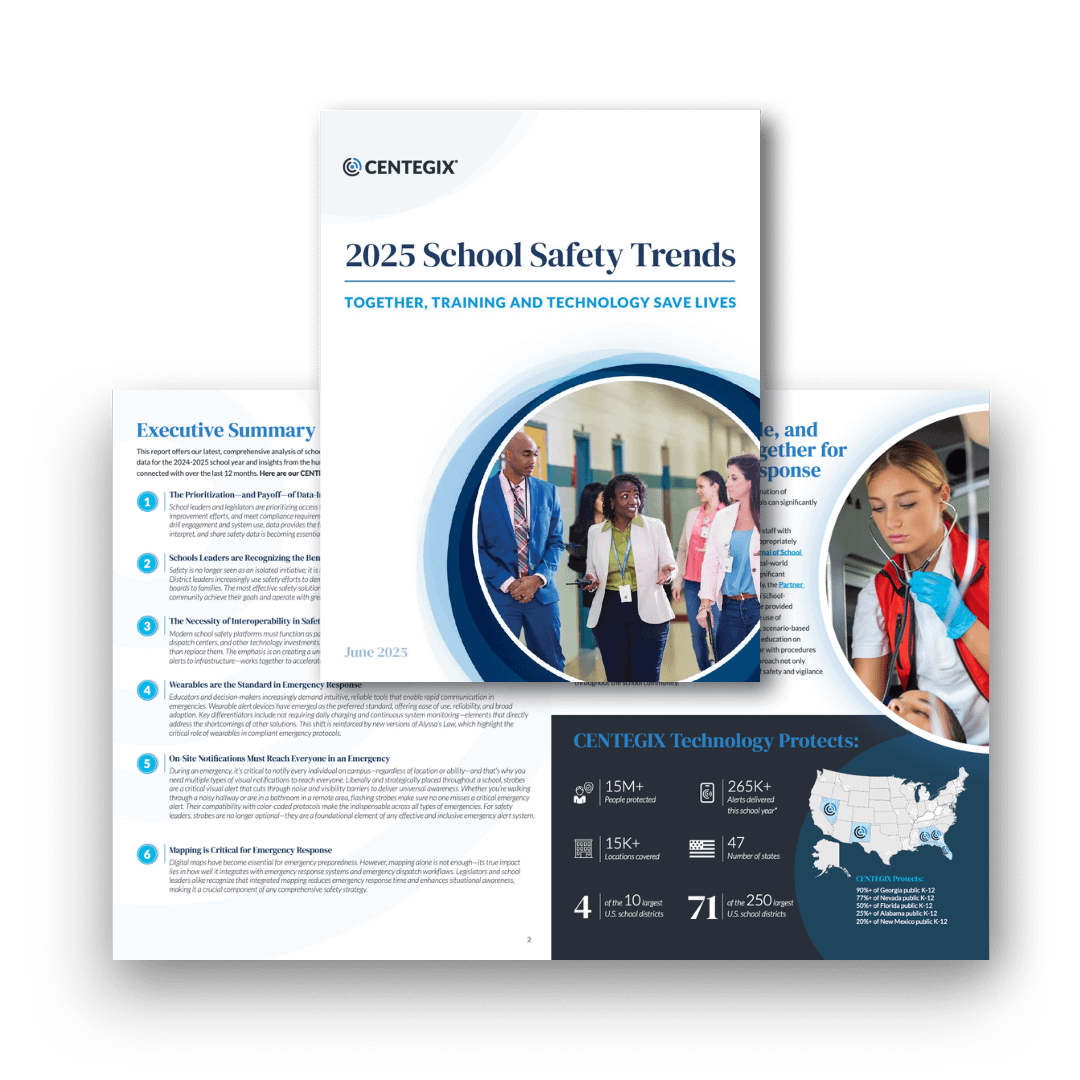CENTEGIX | Education
Michigan School Safety Standards
CENTEGIX | Education
Michigan School Safety Standards
CENTEGIX | Webinar
Safe Schools Now: How CENTEGIX Champions Michigan’s New Safety Initiatives
In our recent webinar, we navigated the complexities of funding opportunities in Michigan. The webinar covered:
- An overview of Michigan’s School Safety Funding: Understand the scope, application process, and best practices for leveraging funds.
- Benefits of CrisisAlert: Learn how our wearable badge technology sets the standard in crisis response.
- Customer Insights: Get insights directly from Dr. Amy Kruppe, Superintendent of Hazel Park School District, about the district’s decision-making process and the impact of CENTEGIX.
Don’t miss these actionable insights to maximize the new funding to create a safer educational environment. View the on-demand webinar today.
Rep. Brenda Carter Introduces Alyssa’s Law: H.B. 4241
Last year, State Rep. Brenda Carter introduced House Bill 4241, also known as Alyssa’s Law, which would require all Michigan school buildings to be equipped with a panic alarm system to rapidly initiate lockdowns and instantly alert law enforcement of the emergency. Watch our video to learn more.
House Bill No. 5503, Section 31aa: Over $150 Million for School Safety Initiatives
In House Bill No. 5503, the Michigan Legislature has released its School Safety Funds for 2024-2025, with Section 31aa receiving $150 million from the State School Aid Fund and $1.5 million from the General Fund. Eligible applicants include districts, intermediate districts, nonpublic schools, and the Michigan Schools for the Deaf and Blind.
School safety initiatives that funds can be spent on include:
- Emergency response system
- Coordination with local law enforcement
- Training for school staff on threat assessment
- Training for school staff and students on threat response
- Training for school staff on crisis communication
- Safety infrastructure such as cameras, hardened vestibules, and technology necessary to operate buzzer systems
- Student Safety Management System
- Any other school safety service or product necessary to improve or maintain security in buildings
- A secure platform for all school safety-related items, including EOP templates, reference documents, and security assessments
- Emergency response system
- Coordination with local law enforcement
- Training for school staff on threat assessment
- Training for school staff and students on threat response
- Training for school staff on crisis communication
- Safety infrastructure such as cameras, hardened vestibules, and technology necessary to operate buzzer systems
- Student Safety Management System
- Any other school safety service or product necessary to improve or maintain security in buildings
- A secure platform for all school safety-related items, including EOP templates, reference documents, and security assessments
These funds must be obligated by December 31, 2024, so Michigan schools should apply for funding to establish and enhance school safety initiatives as soon as possible. An allowable expense under 31aa, the CENTEGIX® CrisisAlert™ emergency response system is the simplest, most reliable solution for obtaining help in an emergency.
We go beyond mobile phone panic alert apps:
Enables a rapid response anywhere on campus
Immediately alerts campus responders with the push of a button.
Provides precise room and floor-level location information to first responders.
One-button activation enables users to easily and rapidly request help.
Intercom, strobe, and desktop notifications in the event of a lockdown.
Request a demonstration today to see for yourself how CrisisAlert meets the safety initiative requirements of 31aa and can make a measurable impact on the safety and security of your district.
Michigan School Safety Task Force
In 2018, Michigan’s School Safety Task Force issued a set of wide-ranging and far-reaching final recommendations for making Michigan public schools safer. Governor Rick Snyder created the School Safety Task Force to ” identify structural and policy recommendations for collaboration, planning, and assessment of school infrastructure and safety policies.” The Task Force recommended that Michigan schools do the following:
- Conduct physical security assessments.
- Implement interior and exterior security measures.
- Implement Emergency Operations Planning (EOP) training.
- Meet state compliance requirements.
- Integrate state guidance regarding emergency drills, definitions of terms, and threats of violence.
- Define the roles of safety personnel in schools.
- Adopt the OK2SAY program, which encourages students to report information about suspicious behaviors, bullying, suicide threats, anxiety, drugs, etc.
- Increase training for safety and security staff.
- Award schools that foster safe environments.
- Increase collaboration among public health experts and educators.
- Implement student behavioral health screenings.
These recommendations underscore Michigan lawmakers’ focus on school safety in recent years. These measures range from addressing behavioral health concerns to instituting school safety curricula to requiring secure infrastructure. Learn more about the recommendations.
K-12 Behavioral Threat Assessment Training
In all of Michigan’s current and upcoming public school policies and legislation, focused attention on students’ mental health is a priority. Last year, the Michigan State Police Office of School Safety (MSP/OSS) hosted Michigan K-12 Behavioral Threat Assessment and Management (Mi-BTAM) training free of charge. This training was intended for school-based threat assessment teams in K-12 public, charter, and private schools. This training taught teams to identify, engage, and work collaboratively with families and students to mitigate situational life factors contributing to thoughts of violence and aggression. Learn more here.
Competitive School Safety Grant Program Funds Safety Measures
The 2022 Competitive School Safety Grant Program (CSSGP) funds measures that fulfill the School Safety Task Force’s Recommendations. The Michigan Legislature appropriated $10 million for these measures. The Grants and Community Services Division (GCSD) of the Michigan State Police (MSP) awarded and administered these competitive grants. Eligible grantees included public schools, nonpublic schools, school districts, and intermediate school districts. These grants fund measures that improve the safety and security of students, staff, and school buildings. Specifically, the CSSGP supports purchasing safety and security technology and equipment. The program also provides funds for technology upgrades and improvements to existing systems.
Michigan legislators will continue to prioritize safety and security in schools. Governor Gretchen Whitmer proposed increased funding for the 2022-23 fiscal year to $66 million in school safety grants. This number equals the total amount of funding for school safety distributed since 2015. According to Whitmer, “with this historic proposal and my larger education budget, which includes resources to improve every kid’s in-class experience, build and renovate school facilities, and retain and recruit more teachers, we will invest in every school and every district across Michigan.” School districts across the state will be eligible for this increased funding.
Recommended Safety Measures
In 2020, the US Office of Community-Oriented Policing Services (COPS) convened a School Safety Working Group that identified ten essential actions schools, school districts, and law enforcement agencies can take to mitigate and prevent school violence. COPS also recommended actions to facilitate swift and effective law enforcement assistance when it is necessary. The Michigan Office of School Safety highlights the role of School Resource Officers and collaboration with law enforcement as essential elements of its approach to making schools safer. COPS guidance regarding school safety measures, therefore, informs their recommendations.
The COPS School Safety Working Group’s “ten essential actions” address both the physical safety and the emotional security of students and staff members:
-
- comprehensive school safety assessment
- school climate
- campus, building, and classroom security
- anonymous reporting systems
- coordination with first responders
- behavior threat assessment and management
- school-based law enforcement
- mental health resources
- drills
- social media monitoring
These actions suggest that a school building’s physical security is directly related to the school community’s health. Increasingly, education leaders are making the case for security as a prerequisite for a robust learning environment.
Federal Funding for Michigan School Safety Solutions
Federal Formula Grants
The list of federal formula grants awarded to Michigan includes:
- IDEA, $479,236,336 (2025 estimate)
- Title I-A, $564,682,139 (2025 estimate)
- Title II-A, $63,467,553 (2025 estimate)
- Title IV-A, $38,339,698 (FY24)
Enhancing School Capacity to Address Youth Violence
The Office of Justice and Juvenile Delinquency Prevention (OJJDP) will fund targeted, evidence-based prevention and intervention programs to address youth violence in schools. The program’s goals are to reduce the incidence of school violence through improved school safety and climate and to prevent youth violence, delinquency, and victimization in the targeted community. Schools implementing school safety solutions should show how these solutions prevent violence and improve the climate of safety in schools. Learn more about the program here.
Community Based Violence Intervention and Prevention Initiative
The Office of Justice Programs created the Community Based Violence Intervention and Prevention Initiative to “prevent and reduce violent crime in communities by supporting comprehensive, evidence-based community-based violence intervention and prevention programs.” Learn more about the program here.
COPS School Violence Prevention Program
The U.S. Department of Justice oversees the COPS School Violence Prevention Program, which distributes funding for evidence-based school safety programs and technologies. School safety solutions that help identify potential dangers are eligible for COPS funding. Districts can also use funds to improve emergency notification and response systems, including Michigan school alert systems. To learn more, visit the COPS website.
BJA’s STOP School Violence Program
The U.S. Department of Justice has also made funds available through the Bureau of Justice Assistance. BJA’s STOP School Violence Program funds the purchase of school safety software designed to help K-12 schools maintain a safe environment. This program’s priorities are recognizing, responding to, and preventing violence on campus. BJA will allocate $82 million to STOP School Violence Program competitive grants in fiscal year 2024.
CENTEGIX | Case Study
North Branch Area Schools Improve Emergency Communication with CENTEGIX CrisisAlert™
After a tragedy took place at a nearby school district in late 2021, administrators at North Branch Area Schools knew they needed to do more to keep their staff and students safe—they needed a solution that would allow them to respond immediately.
Get the details on why North Branch Area Schools chose CENTEGIX CrisisAlert to close communication gaps, and then share with leaders, decision-makers, and other stewards of safety so they can see how we can help your district create a culture of safety.
Download your copy of the case study today.
No Cell Phone, No Service, No Wi-Fi—No Problem
A different approach to incident response. Because in a crisis, every second matters.
CENTEGIX Safety Report
2025 School Safety Trends: Together, Training and Technology Save Lives
Discover our latest, comprehensive analysis of school safety incidents gathered from the CENTEGIX Safety Platform™ usage data for the 2024-2025 school year, as well as insights from the hundreds of school safety and district administration leaders we’ve connected with over the last 12 months, in our report 2025 School Safety Trends: Together, Training and Technology Save Lives.
Download your copy today.

Hear from Our Michigan Educators
We engage with teachers and staff every day to understand how CrisisAlert supports them, and here’s what they’ve shared:
I had a non-verbal student having a meltdown in the lunch room, I was unable to get her to leave with me. I used my Badge and 3 higher up staff members came to assist and get the other students out of the way. This device has been nothing but helpful to our whole school.
A student had a medical emergency in my classroom. If this situation had occurred before I had CrisisAlert, I wouldn’t be able to stay with the student. I think every school employee everywhere should have these.
We received training on the system. The support and trail of the system was easy and clear. We will run a drill for staff/students after the entire team is trained on the system. The system is created for expediency and ease of use, both of which are necessary in an emergency situation.
Championing Safe Schools with Educators and Educator Associations









Discover the Safety Platform
Safety solutions that prioritize speed for the best outcome.
Mapping and locating capabilities provide the precise location—of emergencies, visitors, and safety assets.
A visitor management system screens and locates visitors on your campus.
Protocol development to plan for rapid incident response.
CrisisAlert Is in a Class of Its Own
We don’t just raise the bar. We built it.
CrisisAlert leads the industry in wearable panic button technology. As the most trusted, proven, and deployed solution on the market, it delivers unrivaled reliability, redundancy, notification, and response capabilities.
Unlike other wearable panic buttons, CrisisAlert activates a fully integrated emergency response and notification system, including flashing strobes, intercom announcements, and computer screen takeovers. It’s the only solution with 100% campus-wide coverage that immediately sends a digital map to first responders with precise location details, down to the exact floor and room, detailing every safety asset in proximity of the alert, to protect your staff wherever they are.
In an Emergency, You Need CrisisAlert™
Adverse situations can happen at any moment—from everyday crises such as medical emergencies, severe weather, and physical altercations to extreme situations that threaten your entire campus. The faster you get help to the right location, the better the outcome.
See how our CrisisAlert wearable mobile panic button empowers staff to get help instantly in an emergency.
Ready to Connect with a CENTEGIX Specialist to Learn More?
"*" indicates required fields
*By providing my phone number to CENTEGIX, I agree and acknowledge that CENTEGIX may send text messages to my wireless phone number for any purpose. Message and data rates may apply. CENTEGIX will only send one SMS as a reply, and I will be able to Opt-out by replying “STOP”. **No mobile information will be shared with third parties/affiliates for marketing/promotional purposes.*

Empower Your Educators
with Safety
Explore More Safety Resources
2025 School Safety Trends Report
This report offers our latest, comprehensive analysis of school safety incidents gathered from the CENTEGIX Safety Platform™ usage data for the 2024-2025 school year.
Visitor Management: Best Practices for Your School Safety Plan
CENTEGIX empowers thousands of schools to take control of their visitor management and protect their teachers, students, and staff. Get a copy of our Visitor Management Best Practices Guide today.
Supporting the Unique Safety Needs of Special Education Students and Staff
In our case study, learn how Meade County School District has supported and empowered their special education staff and students with the CENTEGIX Safety Platform™.
School Safety Standards by State
Schools in any state can meet school safety grant funding requirements by choosing the CENTEGIX Safety Platform™. Learn more about school safety in your state.

Creating Safer Environments: Leadership Strategies to Prevent Workplace Violence in Healthcare
Violence in healthcare isn’t just a growing concern—it’s a persistent crisis. Get actionable insights for leaders ready to fight workplace violence in this AHA Associate Podcast.

Reliability is Key to Effective School Safety Solutions
CENTEGIX CrisisAlert is a reliable school safety solution that reduces response times and creates a culture of safety in schools.

How to Comply with Alyssa’s Law in Washington
CENTEGIX CrisisAlert wearable panic buttons enable Washington schools to achieve compliance with Alyssa’s Law, SB 5004.

Board Chair POV: CENTEGIX is the Best Choice for Student Safety
Former DeKalb County Board Chair endorses the CENTEGIX Safety Platform as the best choice for creating safe schools.
SOLUTIONS
INDUSTRIES
RESOURCES
COMPANY
PARTNERS
CONTACT
EVERY. SECOND. MATTERS.®
Explore More Safety Resources
2025 School Safety Trends Report
This report offers our latest, comprehensive analysis of school safety incidents gathered from the CENTEGIX Safety Platform™ usage data for the 2024-2025 school year.
Visitor Management: Best Practices for Your School Safety Plan
CENTEGIX empowers thousands of schools to take control of their visitor management and protect their teachers, students, and staff. Get a copy of our Visitor Management Best Practices Guide today.
Supporting the Unique Safety Needs of Special Education Students and Staff
In our case study, learn how Meade County School District has supported and empowered their special education staff and students with the CENTEGIX Safety Platform™.
School Safety Standards by State
Schools in any state can meet school safety grant funding requirements by choosing the CENTEGIX Safety Platform™. Learn more about school safety in your state.

Creating Safer Environments: Leadership Strategies to Prevent Workplace Violence in Healthcare
Violence in healthcare isn’t just a growing concern—it’s a persistent crisis. Get actionable insights for leaders ready to fight workplace violence in this AHA Associate Podcast.

Reliability is Key to Effective School Safety Solutions
CENTEGIX CrisisAlert is a reliable school safety solution that reduces response times and creates a culture of safety in schools.

How to Comply with Alyssa’s Law in Washington
CENTEGIX CrisisAlert wearable panic buttons enable Washington schools to achieve compliance with Alyssa’s Law, SB 5004.

Board Chair POV: CENTEGIX is the Best Choice for Student Safety
Former DeKalb County Board Chair endorses the CENTEGIX Safety Platform as the best choice for creating safe schools.






